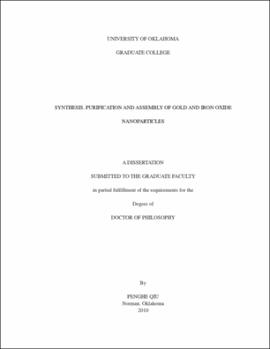| dc.contributor.advisor | Mao, Chuanbin | |
| dc.creator | Qiu, Penghe | |
| dc.date.accessioned | 2019-04-27T21:36:11Z | |
| dc.date.available | 2019-04-27T21:36:11Z | |
| dc.date.issued | 2010 | |
| dc.identifier | 99332413502042 | |
| dc.identifier.uri | https://hdl.handle.net/11244/319127 | |
| dc.description.abstract | The aims of the current research include developing new synthetic strategies to prepare structurally complex gold nanoparticles and new size sorting methods to separate nanoparticles of larger size, as well as studying the assembly of nanoparticles into novel hierarchical structures through both template-assisted and template-free strategies. | |
| dc.description.abstract | In the synthesis section of this dissertation (Chapters 2 & 3), a size controllable synthesis of dendritic gold nanoparticles through a seed-mediated process in ethanol is described. The effect of seeds size and shape as well as the carbon chain length of alkylamines on the formation of dendritic structure was investigated. The synthetic strategy developed is capable of forming dendritic structure on various substrates, like flat or rod-like gold particles. In another work, the shape evolution of gold nanoparticles in a seed-mediated growth as well as the kinetics of reduction of HAuCl4 in the presence of seeds was studied. The reduction of the gold precursor by sodium citrate could be greatly accelerated in the presence of seed nanoparticles. Along with the enhanced reaction kinetics, dramatic shape evolution of gold nanoparticles was observed by changing ratios of precursors. | |
| dc.description.abstract | In the purification section (Chapter 4), a novel method of separating nanoparticles of different sizes in a viscosity gradient was developed. The viscosity gradient was created with polyvinylpyrrolidone (PVP) aqueous solutions. Previously, such size separation was all achieved in the density gradient, while the hidden contribution of viscosity difference inside the density gradient was not well recognized. Through this work, it is clarified that the viscosity can contribute as importantly as density in the size sorting of nanoparticles through rate zonal centrifuge. It was also demonstrated both experimentally and mathematically that the viscosity gradient is more effective in separation of larger sized nanoparticles. | |
| dc.description.abstract | In the assembly section (Chapter 5, 6 & 7), nanoparticles were assembled into three different hierachical structures through both template-assisted and template-free approaches. In the template-assisted assembly, gold nanorods were aligned into ordered 1D linear pattern by using soft biological filamentous, namely bacteria flagella, as templates. Two different ways of assembling nanorods onto flagella were investigated. In another study, a highly commercialized polymer, polyvinylpyrrolidone (PVP), was discovered for the first time to be able to self-assemble into branched hollow fibers. Based on this discovery, two approaches (one through direct deposition of silica onto the PVP aggregate and the other through co-assembly of PVP covered gold nanoparticles with free PVP molecules) by which the self-assembly behavior of PVP could be exploited to template the formation of branched hollow inorganic fibers were demonstrated. In the template-free assembly, a general method for assembling nanoparticle into clusters (NPCs) in an oil-in-water emulsion system was investigated. Detailed studies on the mechanism of formation of NPCs structure, optimized conditions, scalable production and surface chemistry manipulation were carried out. Besides, comparison of the properties of individual and clustered iron oxide nanoparticles was conducted. It was discovered that due to their collective properties, NPCs are more responsive to an external magnetic field and can potentially serve as better contrast enhancement agents than individually dispersed magnetic NPs in Magnetic Resonance Imaging (MRI). | |
| dc.format.extent | 227 pages | |
| dc.format.medium | application.pdf | |
| dc.language | en_US | |
| dc.relation.requires | Adobe Acrobat Reader | |
| dc.subject | Nanoparticles | |
| dc.subject | Nanostructured materials | |
| dc.subject | Gold | |
| dc.subject | Iron oxides | |
| dc.title | Synthesis, Purification and Assembly of Gold and Iron Oxide Nanoparticles | |
| dc.type | text | |
| dc.type | document | |
| dc.thesis.degree | Ph.D. | |
| ou.group | College of Arts and Sciences::Department of Chemistry and Biochemistry | |
